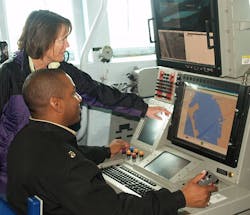Navy to upgrade shipboard radar systems with Compact PCI architectures and Acromag circuit cards
Editor's note: GE Intelligent Platforms changed its name to Abaco Systems on 23 Nov. 2015 as a result of the company's acquisition last September by New York-based private equity firm Veritas Capital.
Officials of the Naval Surface Warfare Center (NSWC) in Crane, Ind., have announced their intention to award a contract to Raytheon for AN/SPS-73 OJ-727(V) tech refresh kits in support of AN/SPS-73(V) surface-search shipboard radar.
Raytheon will receive the contract sole-source because of a lack of detailed drawings and specifications, restricted software rights, and duplicative costs and time necessary to reverse-engineer the system, Navy officials say.
Related: Navy chooses shipboard radar power amplifiers from L3 Electron and CPI Beverly Microwave
The contract award is expected in mid-December, and will involve about 35 tech refresh kits for the AN/SPS-73(V) radar. The contract also involves about 35 programmed Compact PCI cards from Acromag Inc. in Wixom, Mich.
The AN/SPS-73(V)12 is a short-range, two-dimensional, surface search and navigation radar system that provides contact range and bearing information. The radar also provides signal processing and automatic target-detection capability.
The radar can detect surface vessels and aircraft while helping determine the ship's position relative to nearby vessels and navigational hazards. The system's radar processors and displays combine commercial off-the-shelf (COTS) products and specialized technologies, Navy officials say.
Related: Communications and Power to provide traveling wave tubes for Navy shipboard EW systems
The AN/SPS-73(V)12 is replacing the AN/SPS-64(V) and AN/SPS-55(V) systems as navigational radars on the Navy ships. The radars can be configured for ship or land-based applications, and includes its own display indicator.
The AN/SPS-73(V)12 with tech refresh receives National Marine Electronics Association (NMEA) track messages from AN/URN-31 to display automatic identification system (AIS) tracks. Radar video from the AN/SPS-67(V) or AN/SPQ-9B radars flow to the AN/SPS-73(V)12 SAOP console processor in the pilot house to provide the officer of the deck an alternate source of navigation data.
Legacy AN/SPS-73(V)12 systems use a VME-based architecture and host a VxWorks operating system, which runs software version 11.7 on a Synergy Microsystem PowerPC single board computer. The field change 13 upgrade replaces the legacy VME card cage with a Compact PCI architecture, which runs Linux Centos 5.3 operating system on a GE Intelligent Platforms single board computer.
Ethernet interfaces use proprietary radar data service communication middleware protocols developed by Raytheon. External Ethernet interconnections are routed through an Ethernet switch.
The AN/SPS-73(V)12 is tested to MIL-STD-901D for shock, MIL-STD-167 for vibration, and MIL-STD-461D and E for electromagnetic interference.
Raytheon Integrated Defense Systems online at www.raytheon.com, Acromag at www.acromag.com, or NSWC Crane at www.navsea.navy.mil.

